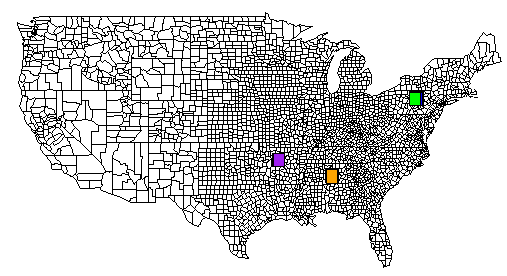我有一个 R data.frame,其中包含跨越整个美国 map 的经度、纬度。当 X 个条目都在一个小的地理区域内,比如几度经度和几度纬度时,我希望能够检测到这一点,然后让我的程序返回地理边界框的坐标。是否有已经这样做的 Python 或 R CRAN 包?如果没有,我将如何确定这些信息?
最佳答案
我能够将 Joran 的回答与 Dan H 的评论结合起来。这是一个示例输出:

python 代码为 R 发出函数:map() 和 rect()。此美国示例 map 是使用以下内容创建的:
map('state', plot = TRUE, fill = FALSE, col = palette())
然后您可以在 R GUI 解释器中相应地应用 rect()(见下文)。
import math
from collections import defaultdict
to_rad = math.pi / 180.0 # convert lat or lng to radians
fname = "site.tsv" # file format: LAT\tLONG
threshhold_dist=50 # adjust to your needs
threshhold_locations=15 # minimum # of locations needed in a cluster
def dist(lat1,lng1,lat2,lng2):
global to_rad
earth_radius_km = 6371
dLat = (lat2-lat1) * to_rad
dLon = (lng2-lng1) * to_rad
lat1_rad = lat1 * to_rad
lat2_rad = lat2 * to_rad
a = math.sin(dLat/2) * math.sin(dLat/2) + math.sin(dLon/2) * math.sin(dLon/2) * math.cos(lat1_rad) * math.cos(lat2_rad)
c = 2 * math.atan2(math.sqrt(a), math.sqrt(1-a));
dist = earth_radius_km * c
return dist
def bounding_box(src, neighbors):
neighbors.append(src)
# nw = NorthWest se=SouthEast
nw_lat = -360
nw_lng = 360
se_lat = 360
se_lng = -360
for (y,x) in neighbors:
if y > nw_lat: nw_lat = y
if x > se_lng: se_lng = x
if y < se_lat: se_lat = y
if x < nw_lng: nw_lng = x
# add some padding
pad = 0.5
nw_lat += pad
nw_lng -= pad
se_lat -= pad
se_lng += pad
# sutiable for r's map() function
return (se_lat,nw_lat,nw_lng,se_lng)
def sitesDist(site1,site2):
#just a helper to shorted list comprehension below
return dist(site1[0],site1[1], site2[0], site2[1])
def load_site_data():
global fname
sites = defaultdict(tuple)
data = open(fname,encoding="latin-1")
data.readline() # skip header
for line in data:
line = line[:-1]
slots = line.split("\t")
lat = float(slots[0])
lng = float(slots[1])
lat_rad = lat * math.pi / 180.0
lng_rad = lng * math.pi / 180.0
sites[(lat,lng)] = (lat,lng) #(lat_rad,lng_rad)
return sites
def main():
sites_dict = {}
sites = load_site_data()
for site in sites:
#for each site put it in a dictionary with its value being an array of neighbors
sites_dict[site] = [x for x in sites if x != site and sitesDist(site,x) < threshhold_dist]
results = {}
for site in sites:
j = len(sites_dict[site])
if j >= threshhold_locations:
coord = bounding_box( site, sites_dict[site] )
results[coord] = coord
for bbox in results:
yx="ylim=c(%s,%s), xlim=c(%s,%s)" % (results[bbox]) #(se_lat,nw_lat,nw_lng,se_lng)
print('map("county", plot=T, fill=T, col=palette(), %s)' % yx)
rect='rect(%s,%s, %s,%s, col=c("red"))' % (results[bbox][2], results[bbox][0], results[bbox][3], results[bbox][2])
print(rect)
print("")
main()
这是一个示例 TSV 文件 (site.tsv)
LAT LONG
36.3312 -94.1334
36.6828 -121.791
37.2307 -121.96
37.3857 -122.026
37.3857 -122.026
37.3857 -122.026
37.3895 -97.644
37.3992 -122.139
37.3992 -122.139
37.402 -122.078
37.402 -122.078
37.402 -122.078
37.402 -122.078
37.402 -122.078
37.48 -122.144
37.48 -122.144
37.55 126.967
使用我的数据集,我的 python 脚本的输出,显示在美国 map 上。为了清晰起见,我更改了颜色。
rect(-74.989,39.7667, -73.0419,41.5209, col=c("red"))
rect(-123.005,36.8144, -121.392,38.3672, col=c("green"))
rect(-78.2422,38.2474, -76.3,39.9282, col=c("blue"))
2013-05-01 对 Yacob 的补充
这两行给你一个总体目标...
map("county", plot=T )
rect(-122.644,36.7307, -121.46,37.98, col=c("red"))
如果你想缩小 map 的一部分,你可以使用 ylim 和 xlim
map("county", plot=T, ylim=c(36.7307,37.98), xlim=c(-122.644,-121.46))
# or for more coloring, but choose one or the other map("country") commands
map("county", plot=T, fill=T, col=palette(), ylim=c(36.7307,37.98), xlim=c(-122.644,-121.46))
rect(-122.644,36.7307, -121.46,37.98, col=c("red"))
你会想要使用“世界” map ...
map("world", plot=T )
我已经很久没有使用我在下面发布的这个python代码了,所以我会尽力帮助你。
threshhold_dist is the size of the bounding box, ie: the geographical area
theshhold_location is the number of lat/lng points needed with in
the bounding box in order for it to be considered a cluster.
这是一个完整的例子。 TSV 文件位于 pastebin.com 上。我还包含了一个从 R 生成的图像,其中包含所有 rect() 命令的输出。
# pyclusters.py
# May-02-2013
# -John Taylor
# latlng.tsv is located at http://pastebin.com/cyvEdx3V
# use the "RAW Paste Data" to preserve the tab characters
import math
from collections import defaultdict
# See also: http://www.geomidpoint.com/example.html
# See also: http://www.movable-type.co.uk/scripts/latlong.html
to_rad = math.pi / 180.0 # convert lat or lng to radians
fname = "latlng.tsv" # file format: LAT\tLONG
threshhold_dist=20 # adjust to your needs
threshhold_locations=20 # minimum # of locations needed in a cluster
earth_radius_km = 6371
def coord2cart(lat,lng):
x = math.cos(lat) * math.cos(lng)
y = math.cos(lat) * math.sin(lng)
z = math.sin(lat)
return (x,y,z)
def cart2corrd(x,y,z):
lon = math.atan2(y,x)
hyp = math.sqrt(x*x + y*y)
lat = math.atan2(z,hyp)
return(lat,lng)
def dist(lat1,lng1,lat2,lng2):
global to_rad, earth_radius_km
dLat = (lat2-lat1) * to_rad
dLon = (lng2-lng1) * to_rad
lat1_rad = lat1 * to_rad
lat2_rad = lat2 * to_rad
a = math.sin(dLat/2) * math.sin(dLat/2) + math.sin(dLon/2) * math.sin(dLon/2) * math.cos(lat1_rad) * math.cos(lat2_rad)
c = 2 * math.atan2(math.sqrt(a), math.sqrt(1-a));
dist = earth_radius_km * c
return dist
def bounding_box(src, neighbors):
neighbors.append(src)
# nw = NorthWest se=SouthEast
nw_lat = -360
nw_lng = 360
se_lat = 360
se_lng = -360
for (y,x) in neighbors:
if y > nw_lat: nw_lat = y
if x > se_lng: se_lng = x
if y < se_lat: se_lat = y
if x < nw_lng: nw_lng = x
# add some padding
pad = 0.5
nw_lat += pad
nw_lng -= pad
se_lat -= pad
se_lng += pad
#print("answer:")
#print("nw lat,lng : %s %s" % (nw_lat,nw_lng))
#print("se lat,lng : %s %s" % (se_lat,se_lng))
# sutiable for r's map() function
return (se_lat,nw_lat,nw_lng,se_lng)
def sitesDist(site1,site2):
# just a helper to shorted list comprehensioin below
return dist(site1[0],site1[1], site2[0], site2[1])
def load_site_data():
global fname
sites = defaultdict(tuple)
data = open(fname,encoding="latin-1")
data.readline() # skip header
for line in data:
line = line[:-1]
slots = line.split("\t")
lat = float(slots[0])
lng = float(slots[1])
lat_rad = lat * math.pi / 180.0
lng_rad = lng * math.pi / 180.0
sites[(lat,lng)] = (lat,lng) #(lat_rad,lng_rad)
return sites
def main():
color_list = ( "red", "blue", "green", "yellow", "orange", "brown", "pink", "purple" )
color_idx = 0
sites_dict = {}
sites = load_site_data()
for site in sites:
#for each site put it in a dictionarry with its value being an array of neighbors
sites_dict[site] = [x for x in sites if x != site and sitesDist(site,x) < threshhold_dist]
print("")
print('map("state", plot=T)') # or use: county instead of state
print("")
results = {}
for site in sites:
j = len(sites_dict[site])
if j >= threshhold_locations:
coord = bounding_box( site, sites_dict[site] )
results[coord] = coord
for bbox in results:
yx="ylim=c(%s,%s), xlim=c(%s,%s)" % (results[bbox]) #(se_lat,nw_lat,nw_lng,se_lng)
# important!
# if you want an individual map for each cluster, uncomment this line
#print('map("county", plot=T, fill=T, col=palette(), %s)' % yx)
if len(color_list) == color_idx:
color_idx = 0
rect='rect(%s,%s, %s,%s, col=c("%s"))' % (results[bbox][2], results[bbox][0], results[bbox][3], results[bbox][1], color_list[color_idx])
color_idx += 1
print(rect)
print("")
main()

关于python - 检测地理集群,我们在Stack Overflow上找到一个类似的问题: https://stackoverflow.com/questions/10108368/